Monsteras come in many different varieties, and one of the most beautiful is monstera borsigiana. This large monstera variety looks very similar to the ever-popular monstera deliciosa, and is actually a variation of that variety, but with a few distinct differences.
Here’s everything you need to know about how to add this monstera variety to your collection and care for it.
Table of Contents
How to Identify Monstera Borsigiana
Monstera borsigiana is tricky to differentiate from monstera deliciosa, especially when they’re young, because they look so similar. But borsigiana is slightly smaller than deliciosa, and they grow even faster. Borsigianas also tend to fenestrate in neater, more even rows while deliciosa fenestrates much more randomly.
The easiest way to distinguish the two varieties is to look at the stem: deliciosa usually forms ruffles or bumps where the stem meets the base of the leaf while borsigiana doesn’t.
Another cool feature of monstera borsigiana is that this subspecies tends to mutate more often to display variegation, a highly sought-after trait for many plant lovers! The variegated borsigiana is called monstera albo, and it’s a bit easier to find than many other variegated varieties because they propagate more readily from cuttings.
Where to Find Monstera Borsigiana
You can often find these in local nurseries and even chain home improvement stores like Home Depot and Lowe’s. They may be mislabeled as monstera deliciosa (or even split-leaf philodendron), but make sure to check for ruffles on the stem. If there are none, you’ve most likely found a borsigiana!
You can also find these plants online. Try searching “monstera borsigiana” on Etsy, eBay, or even Facebook Marketplace. You may find established plants or cuttings.
Here are our favorite Etsy shops for buying plants online:
You can also find these plants from other online sellers, but make sure to check reviews and ratings to make sure you’re buying from a reputable seller.
How to Care for Monstera Borsigiana
Good news! You can care for a monstera borsigiana the same way you would a monstera deliciosa, or most other monstera varieties. (But not monstera obliqua. That’s a whole other story!)
If you’re already an adept monstera owner, you’re good to go! But if you’re just getting started with caring for these plants, here’s a review:
Potting and soil
Use a peaty soil that drains well so your monstera doesn’t dry out too quickly or sit in water. They don’t like wet feet! Try mixing a few handfuls of peat moss into regular potting soil or even cactus mix. Choose a pot with excellent drainage that’s about 2-3 inches larger than your plant’s root ball.
You can also grow these plants with hydroponics or LECA!
Light
All monstera varieties, borsigiana included, prefer bright, indirect sunlight. This means that you should place them close to a bright window but not directly in the sun’s rays (this can scorch the leaves!).
Without proper light, your monstera will not grow as quickly, will be more prone to overwatering and root rot, and may not develop splits. So make sure it gets plenty of light! If you can’t provide enough natural sunlight, you can supplement with a grow light.
Water
Monsteras like their soil to stay evenly moist, so make sure to water when the top 2 inches of soil feel dry to the touch or when a moisture meter reads 3-4. Slowly add water to the soil until it just starts to drain out the bottom, then empty the drainage tray immediately.
Temperature and humidity
Remember, these are tropical plants, so they do best in warm, somewhat humid conditions. Most room temperatures and humidity levels are fine, but if you live in a very dry area or use indoor climate control, you may want to set up a humidifier near your borsigiana or place the plant, pot and all, on a shallow tray filled with pebbles and water. This will create some humidity around the plant as the water evaporates.
Make sure to keep your plant away from heating and AC vents, space heaters, drafts, and fireplaces.
Fertilizer
Borsigianas need the right balance of nutrients to grow healthy roots, strong stems, and those beautiful fenestrated leaves! These nutrients occur naturally in nature, but a potted monstera can use up all the nutrients in its potting soil in just a few months!
If you’ve had your borsigiana for more than a month or so, make sure to fertilize regularly with Monstera Plant Food or another 5-2-3 liquid fertilizer. Use with each watering during the spring and summer (aka monstera growing season) and with every other watering during the fall and winter.
Troubleshooting
No matter how carefully you take care of your monstera borsigiana, you’ll most likely run into some problems! Check out our monstera troubleshooting guides to diagnose and treat the problem.
What to Do if Your Monstera Leaves Won’t Split
What’s Wrong With My Monstera: Monstera Leaf Troubleshooting
How to Get Insects OFF Your Monstera
4 Signs Your Monstera Is Overwatered
4 Signs Your Monstera Needs More Light
Your monstera borsigiana just might become your new favorite houseplant!





